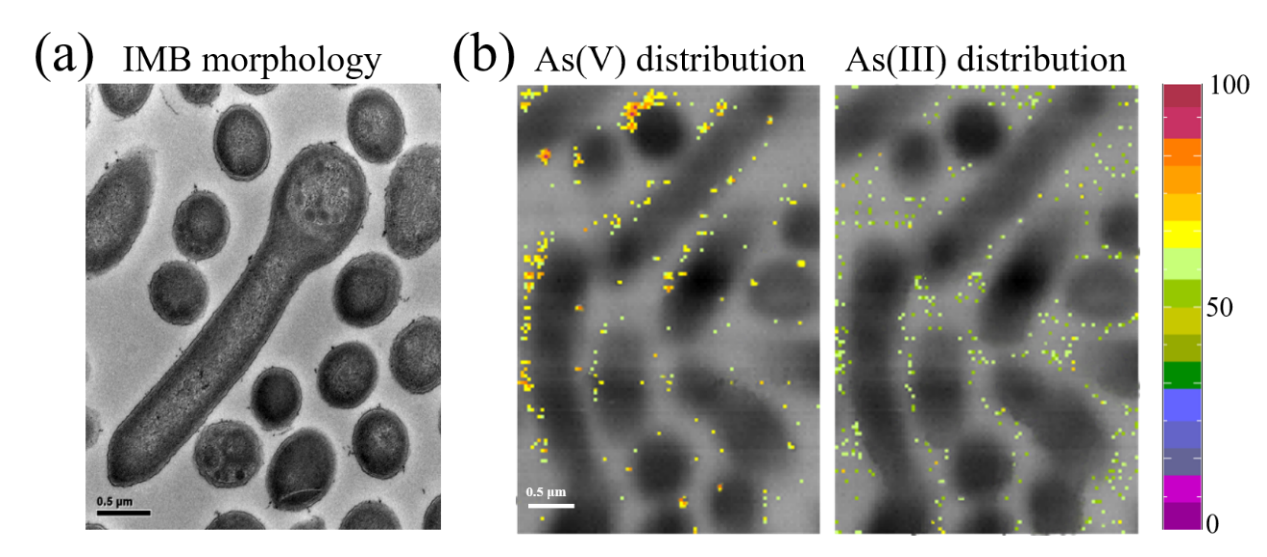Scientific Achievement
Dr. Ye Li, Prof. Chuanyong Jing of Shandong University, and Associate Prof. Haixia Tian of Northwest A&F University, in collaboration with the Soft X-ray Spectromicroscopy Beamline (BL08U1A)of the Shanghai Synchrotron Radiation Facility, have utilized synchrotron radiation X-ray microscopy (STXM) and in situ XANES spectroscopy to conduct the in situ observation of the arsenic reduction process by the typical arsenic-reducing bacterium, Alkaliphilus sp. IMB, revealing that the reduction of pentavalent arsenic (As(V)) by IMB occurs at the cell membrane.
Significance and Impact
Arsenic-reducing bacteria (AsRB) are important environmental mediators leading to arsenic release, and this work provides new ideas for characterizing the process of in situ oxidative reduction of metal pollutants by microorganisms. The results, entitled "Arsenic mobilization in nZVI residue by Alkaliphilus sp. IMB: Comparison between static and flowing incubation", were published in Environmental Pollution in 2023.
Research background
Arsenic-reducing bacteria (AsRB) have been recognized as important environmental mediators of arsenic release, facilitating the release of arsenic from the solid phase to the water column by reducing As(V) to the more mobile trivalent arsenic (As(III)). However, some studies have found that AsRB does not promote the release of arsenic.This contradiction centers on whether the reduced As(III) can be adsorbed again by iron-containing minerals. Previous studies often conducted experiments in closed static systems, focusing on the strength of the adsorption capacity of secondary iron-bearing minerals on As(III) and neglecting the rate of As(III) reabsorption. The group suggests that the difference between the reduction rate of As(V) and the rate of As(III) reabsorption may be the key to assessing the role of AsRB on the migratory release of arsenic from the adsorbed state.
Main research contents
To verify this scientific hypothesis, an arsenic-reducing bacterial strain, IMB, was isolated from arsenic-contaminated sediments and analyzed by 16S rRNA analysis to be of the genus Alkaliphilus.IMB possesses the arsenic-reducing gene arrA, which, when co-cultivated with 1 mM As(V), reduces about 80% of As(V) to As(III) within 120 h. In situ characterization of its As(V) reduction process using synchrotron radiation scanning transmission X-ray microscopy (STXM) revealed that the dissolved As(V) was attached to the cell surface, while the reduction product As(III) was dispersed in the cell periphery. This result suggests that the process of As(V) reduction by IMB occurs at the outer cell membrane. Previously, in order to study the location of As(V) reductase in the cell, it was necessary to separate various parts of the cell by conventional biological means, which was complicated and time-consuming. In this study, STXM was used to characterize the morphological distribution of arsenic in cells, which is clear and easy to operate.
To further investigate the effect of As(III) resorption rate on arsenic transport release, two sets of experiments, static and in situ flow, were carried out. In the closed static incubation experiments, IMB was co-cultured with zero-valent iron nano-ferrous waste sludge (nZVI) with adsorbed arsenic, and the results of hydrochemistry and As K-edge XANES spectroscopy revealed that the product of the IMB reduction, As(III), was re-sorbed to the solid phase in the static experiments, and thus As(V) reduction did not contribute to the release of arsenic. In contrast to the static tests, IMB greatly promoted arsenic release in the in situ flow incubation experiments. Under in situ flow conditions, the underlying reason for the strong promotion of arsenic release by IMB was the inhibition of the reabsorption process of dissolved As(III), which could completely reduce dissolved As(V) to As(III) in a short period of about 1 h. However, the reduction product, As(III), could not be rapidly reabsorbed to the solid phase and flowed out with the water.

Fig. 1. (a) TEM characterization of Alkaliphilus sp. IMB morphology; (b) STXM characterization of the distribution of As(V) and As(III) after co-cultivation of IMB with As(V).
Bright Future Prospects
The static incubation experimental conditions were similar to those of environmental lakes and reservoirs, etc., while the in situ flow experimental conditions were similar to groundwater situations. In this paper, we propose that the difference between As(V) reduction rate and As(III) resorption rate is the key to influence the arsenic release from AsRB migration, and hypothesize that AsRB may not have a significant effect on arsenic release in static environments, whereas it may contribute significantly to arsenic release in flowing water environments. This study provides new ideas for characterizing the microbial in situ oxidative reduction process of metal pollutants.
Contact
BL08U1A user coordinator:Zijian Xu,xuzj@sari.ac.cn, 13681612583
Publication
Li Ye, Haixia Tian, Chuanyong Jing,* Arsenic mobilization in nZVI residue by Alkaliphilus sp. IMB: Comparison between static and flowing incubation. Environmental Pollution 319, 121019 (2023).
附件下载:
